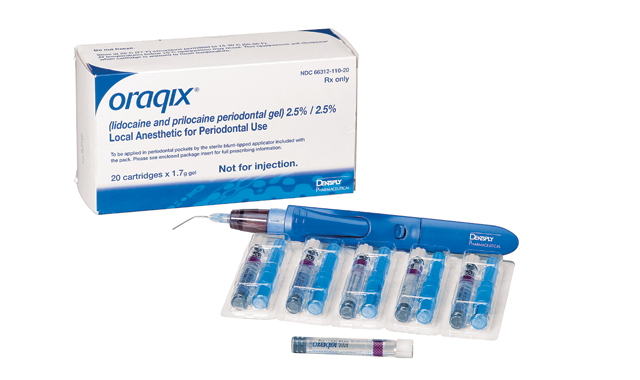I Use That: Oraqix gel
Scaling and root planing can be an uncomfortable experience for patients, which is why it’s so important to choose an effective anesthetic that’s appropriate for each individual case. Kim Miller, RDH, and M.E. Sanders, RDH, lead profitability coaches with Inspired Hygiene, talk about what they use for certain situations and why they often turn to Oraqix® for scaling and root planing treatments.

Scaling and root planing can be an uncomfortable experience for patients, which is why it’s so important to choose an effective anesthetic that’s appropriate for each individual case. Kim Miller, RDH, and M.E. Sanders, RDH, lead profitability coaches with Inspired Hygiene, talk about what they use for certain situations and why they often turn to Oraqix® for scaling and root planing treatments.
What Kim Miller says about Oraqix
I’ve been using Oraqix1 since it was first introduced. When the rep came into the office and showed Oraqix to me, I rubbed a small amount of it on my gums and within seconds my gum tissue started to get numb. I thought to myself, “If Oraqix is this effective on my gum tissue, how much more effective will it be when I deliver it to the site of the infection? This is going to make my patients much more comfortable during treatment.” That’s my primary interest-keeping my patients comfortable. Oraqix does that.
Another advantage of using Oraqix is its neutral to basic pH, which makes it safe to use in and around inflamed and denuded tissues. Other popular topical anesthetics are more acidic and contraindicated for inflamed tissue. For example, Cetacaine® topical anesthetic2 has a pH below 3.0, is highly acidic, and is contraindicated for use on large areas of inflamed and denuded tissue. Users should be aware that Cetacaine has a maximum usage of .4ml of liquid or a bead of gel about half an inch long. That’s only going to be enough for about two teeth, meaning clinicians may feel the need to exceed the maximum dosage to get the desired level of patient comfort.
The opposite is true with Oraqix. Initially I was using it too sparingly, and I believe most clinicians have that tendency. Be generous with Oraqix because it is safe, has a neutral pH and you may use up to five cartridges per treatment session. It’s safe to reapply but I rarely need to if I’ve filled each pocket adequately from the start.
When a patient presents with severe infection and deeper pockets, I opt for an injectable like Citanest Plain, which can be used on patients who will not tolerate a vasoconstrictor. I worked for a periodontist and we used a combination of Oraqix and injectable, depending on which quadrants we were working in and the extent of disease. Oraqix works well on patients with gingivitis to moderate periodontal disease. I want my patients to come back and continue to seek care, so keeping them comfortable is a top priority.
More from the author: I Use That: Zirc Crystal HD Mouth Mirrors
There’s a new gingivitis code, D4346, introduced by the ADA on Janurary 1, 2017, that we should be aware of. This treatment code is indicated for moderate to advanced inflammation in suprabony pockets. These pockets could be ≥4 mm deep. They’re infected and bleeding and allow bacteria into the blood stream, but there’s no bone loss. Oraqix is the perfect non-injectable anesthetic to use when treating patients in this category. In this case, my job is to disrupt the bacterial biofilm that is causing the infection, and I want my patients to be comfortable so I can thoroughly disrupt the biofilm.
In my experience, Oraqix makes it easy to provide a higher level of care for patients and to keep them comfortable at the same time.
What M.E. Sanders says about Oraqix
I like using Oraqix for scaling and root planing because it allows me to focus on patient care rather than waiting for the doctor to come give an injection. I can get right to work, and my patients don’t experience any discomfort. It works within about 20 seconds or so after application, and patients don’t have to worry about being numb for the next two to four hours.
I demonstrate to patients that I’m using a nozzle instead of a needle to apply the anesthetic exactly where I need it to go. I do let the patient know that if he or she has any discomfort I can reapply, but I typically don’t need to. Oraqix is especially great for patients who are worried about pain. I talk with them about the procedure and introduce them to Oraqix early on in the diagnostic process. That way, when they come back for perio therapy, they’re prepared.
Oraqix saves me a lot of time. It is delivered right into the pocket and becomes a gel once it comes in contact with “warm” tissues. Another advantage is the applicator can be bent to assist in delivery throughout the mouth. It’s easy to apply and it makes my patients much more comfortable during non-surgical perio therapy procedures.
If you have not tried Oraqix, give it a try. You will love it and your patients will love you.
1. Oraqix® is a registered trademark of Dentsply International
2. Cetacaine® is a registered trademark of Cetylite® Inc.
ACTIVA BioACTIVE Bulk Flow Marks Pulpdent’s First Major Product Release in 4 Years
December 12th 2024Next-generation bulk-fill dental restorative raises the standard of care for bulk-fill procedures by providing natural remineralization support, while also overcoming current bulk-fill limitations.